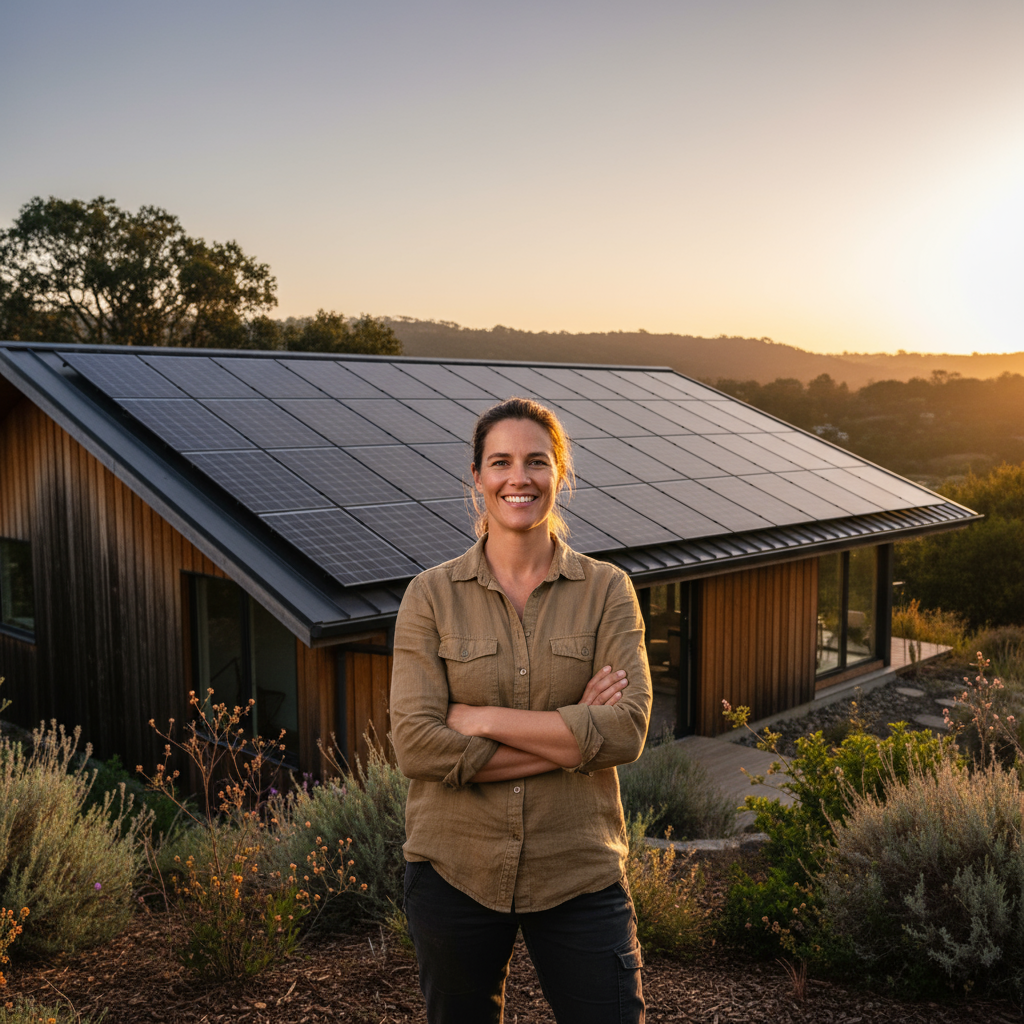
Table of Contents
Introduction
Climate change isn’t some distant problem anymore—it’s happening right now. And while it might feel overwhelming, here’s the thing: you have more power than you think. Every choice you make, from your morning coffee to your evening commute, shapes your carbon footprint. But here’s what gets me excited—small changes can create ripple effects that go way beyond what you’d expect.
So what exactly is this “carbon footprint” everyone talks about? Think of it as your personal climate signature. It’s all the greenhouse gases you’re responsible for—the electricity powering your home, the fuel in your car, even that burger you had for lunch. These emissions add up. But once you understand how they connect to your daily routine, you can start making choices that actually matter.
Now, I get it. You’re busy. The last thing you need is another complicated lifestyle overhaul. Good news—sustainable living doesn’t have to turn your world upside down. Take food, for example. Switching to more plant-based meals can slash your emissions significantly. And if you’re wondering where to start, these vegan meal prep recipes make it ridiculously easy (and delicious). Plus, getting better at time management skills helps you actually stick with these new habits instead of abandoning them after a week.
Here’s where it gets interesting—going green isn’t just about saving the planet. It’s about feeling better too. Take screen time. Cutting back reduces energy consumption and gives your brain a break from digital overload. Learning how to reduce screen time shows you practical ways to find that balance we all desperately need. And when you’re feeling good about yourself? That’s when sustainable habits really stick. Maybe try practicing gratitude or finally tackle how to overcome procrastination—both will fuel your commitment to living greener.
But let’s zoom out for a second. Your individual efforts matter, but they’re part of something bigger. Understanding how to reduce greenhouse gas emissions on a community level amplifies your impact exponentially. And when you explore how to reduce your environmental footprint from multiple angles, you start seeing connections everywhere—between your choices, your community, and global change.
What You’ll Learn in This Guide
Ready to dive in? Here’s exactly what we’re going to cover together:
- Understanding Your Carbon Footprint: We’ll break down what actually counts and how your daily activities contribute to emissions—no confusing jargon, just clear explanations that make sense.
- Actionable Lifestyle Changes: Real strategies for your home, transportation, and diet that won’t turn your life upside down but will make a genuine difference.
- Community and Policy Influence: How to amplify your impact by working with others and supporting the changes that create lasting progress.
- The Benefits of Reducing Your Footprint: Spoiler alert—this isn’t just about polar bears. We’re talking better health, more money in your pocket, and an overall higher quality of life.
Throughout this journey, we’ll dig into practical strategies backed by real science and tested by real people. (And if motivation starts to wane—which happens to everyone—you might want to check out our guide on how to stay motivated to keep your momentum going.)
This isn’t just another how-to guide. It’s about joining a movement that’s already changing the world, one person at a time. Whether you’re ready to make dramatic changes or you just want to start with baby steps, every action counts. And honestly? Some of these changes might surprise you with how much they improve your life in unexpected ways.
So let’s get started. The planet needs us, but more than that—we need this. A sustainable future isn’t just about environmental responsibility; it’s about creating a life that feels good, makes sense, and leaves something positive behind. Ready to see what’s possible when you align your values with your actions?

Want to shrink your carbon footprint? You’re not alone. More people than ever are looking at their daily habits and wondering how they can do better for the planet—and honestly, for themselves too. The good news? You don’t need to completely overhaul your life to make a real difference. Small, smart changes in how we use energy, get around, eat, and handle waste can add up to something pretty meaningful. Plus, many of these shifts actually save you money and boost your health along the way. Let’s walk through what really matters when it comes to your carbon footprint and how you can tackle it without losing your mind.
Understanding the Key Contributors to Your Carbon Footprint
Here’s the thing—before you start making changes, you need to know where your emissions are actually coming from. Think of it like a budget: you can’t cut spending if you don’t know where your money’s going. Your carbon footprint comes from four main areas that probably won’t surprise you: the energy you use at home, how you get around, what you eat, and what you throw away. Once you see the big picture, you can figure out where to focus your efforts for maximum impact. If you’re ready to dig deeper, checking out practical ways to reduce your carbon footprint gives you a solid starting point for making changes that actually stick.
Let’s break it down. Your home energy use is probably eating up a big chunk of your footprint—think heating, cooling, lights, and all those devices we can’t seem to live without. Then there’s transportation, which can be a real kicker if you’re driving a lot or flying frequently. Food choices matter more than most people realize, especially when it comes to meat and dairy (the production process is pretty resource-heavy). And don’t forget about waste—all that stuff heading to landfills doesn’t just disappear. Understanding these pieces of the puzzle helps you see where you can make changes that actually matter.
Primary Sources of Carbon Emissions in Daily Life
Not all carbon sources are created equal. Some pack a much bigger punch than others. Here’s what you’re dealing with:
- Energy Consumption at Home: Your heating and cooling systems are probably the biggest energy hogs, followed by lighting and all your gadgets. The good news? Switching to efficient appliances and getting a smart thermostat can cut your emissions (and your bills) pretty dramatically.
- Transportation: Whether it’s your daily commute or that vacation flight, getting from point A to point B adds up fast. But you’ve got options—carpooling, biking, public transit, or even just combining errands into one trip can make a real dent.
- Food Consumption: This one surprises people. Producing meat and dairy requires tons of resources and generates serious greenhouse gases. You don’t have to go full vegetarian, but eating more plants and wasting less food goes a long way.
- Waste Production: All that trash in landfills? It’s creating methane, which is bad news for the climate. Recycling, composting, and buying stuff with less packaging helps keep waste out of the ground.
Once you know where your biggest impacts are coming from, you can make smarter choices about where to put your energy. No point in stressing over tiny changes when there are bigger wins waiting for you.
Practical Steps to Reduce Your Carbon Footprint
Now that you know what you’re working with, let’s talk action. The best part? You don’t need to turn your life upside down to see results. Small tweaks in your home energy use, how you get around, and what you eat can add up to something pretty impressive. And if you’re curious about the food angle, learning about plant-based diet benefits might surprise you—it’s not just good for the planet, it’s good for you too.
Here’s what actually works: upgrading to energy-efficient stuff when your old appliances die anyway, finding smarter ways to get around that don’t leave you stranded, and shifting toward more plant-forward meals (without giving up everything you love). Add some basic waste reduction habits, and you’re already way ahead of where you started. The key is picking changes that fit your life, not fighting against it.
Effective Actions for Lowering Your Carbon Footprint
Ready to get started? Focus on these concrete steps that won’t derail your routine:
- At Home Energy Efficiency: Start with the easy wins—LED bulbs, unplugging devices you’re not using, and maybe sealing up those drafty windows. When it’s time to replace appliances, go for the energy-efficient ones. Your electric bill will thank you.
- Transportation Alternatives: Look for opportunities to combine trips, try biking for short distances, or explore public transit if it works in your area. If you’re car shopping, consider something more fuel-efficient or electric. Even carpooling once a week helps.
- Plant-Based and Sustainable Diet: You don’t have to become a vegetarian overnight. Try “Meatless Monday” or swap in plant-based options a couple times a week. Buy local when you can, and definitely work on wasting less food—it’s money down the drain anyway.
- Waste Reduction and Recycling: Get better at recycling (check your local rules—they vary!), start composting if possible, and pay attention to packaging when you shop. Those little changes add up faster than you’d think.
The beauty of this approach is that it works on multiple levels. You’re helping the environment, often saving money, and usually improving your health in the process. Plus, when you start making these changes, you become part of a bigger movement that’s actually making a difference in fighting climate change. Not bad for some simple lifestyle tweaks, right?

Here’s the truth about reducing your carbon footprint: it’s one of the best things you can do for the planet—and for yourself. We’ve covered a lot of ground together, looking at everything from your home energy use to what’s on your dinner plate, how you get around town, and even what happens to your trash. The cool thing is, once you see where your biggest impacts come from, you can focus your efforts where they’ll actually make a difference. And those small changes? They add up faster than you might think.
But here’s what I love about going greener—it’s not just about saving the planet (though that’s pretty important). You’ll probably feel better too. Eating more plants, spending less time glued to screens, using less energy—these aren’t sacrifices. They’re upgrades to your life. Plus, let’s talk money. Many sustainable choices actually save you cash in the long run. Lower energy bills, less food waste, fewer impulse purchases. Your wallet will thank you. And when you get involved in community efforts or start advocating for better policies? That’s where your impact really starts to multiply.
Ready to put this into action? Start with something that feels manageable—maybe adding a few more plant-based meals to your week. (Trust me, they can be delicious.) Our vegan meal prep recipes make it super easy to get started without the stress. And since building new habits takes time and planning, working on your time management skills can help you weave these changes into your routine smoothly. Oh, and cutting back on screen time? It’s a win-win—less energy used, more mental clarity. Check out these practical tips on how to reduce screen time that actually work.
Want to think bigger? Individual action is powerful, but it’s even better when combined with community efforts and policy changes. This comprehensive guide on how to reduce your environmental footprint dives into those broader strategies—from getting involved locally to supporting sustainable innovations. Because let’s face it, we’re all in this together, and the most lasting change happens when personal commitment meets collective action.
Look, I get it—sometimes this whole sustainability thing can feel overwhelming. But you don’t have to be perfect. Set goals that feel achievable, celebrate the wins (even the small ones), and remember that every choice you make matters. Your kids, your community, future generations—they’re all counting on people like you to make thoughtful decisions. So start where you are, use what you have, do what you can. The planet needs more people who care, and you’re already one of them.
Frequently Asked Questions
-
What simple changes can I make to reduce my carbon footprint?
- Switch to energy-efficient appliances, walk or bike more, and reduce meat consumption.
-
How does eating less meat help the environment?
- Meat production generates high greenhouse gases; eating plant-based reduces emissions.
-
Can planting trees offset my carbon footprint?
- Trees absorb CO2, but it’s best combined with reducing emissions directly.
-
Is it expensive to live a low-carbon lifestyle?
- Many changes save money long-term, like energy efficiency and reduced waste.
-
How can communities help in reducing carbon footprints?
- Through local initiatives, policy advocacy, and promoting sustainable practices.
